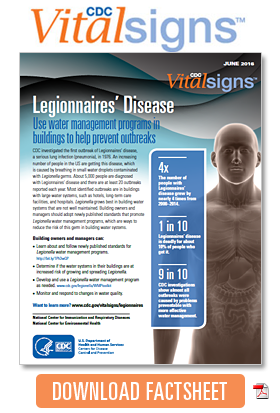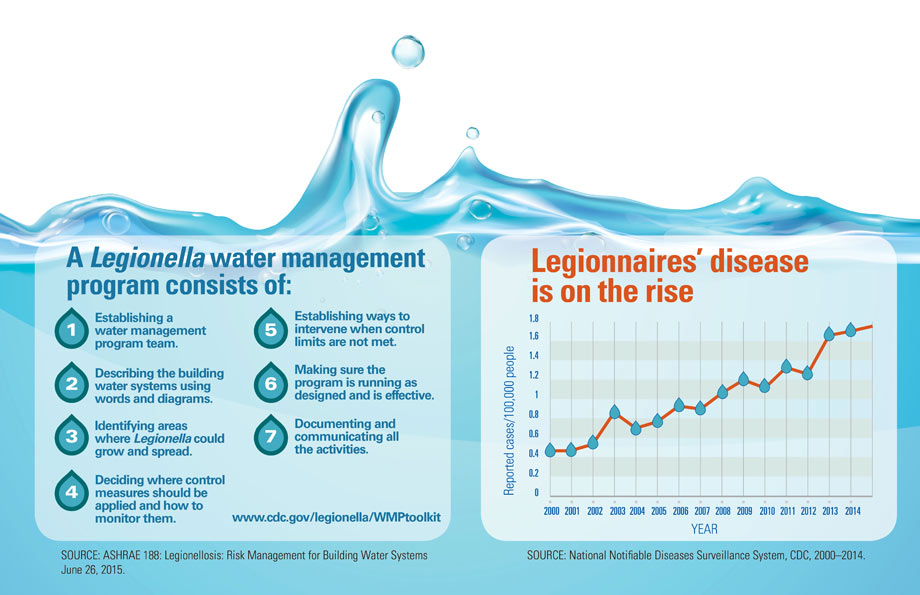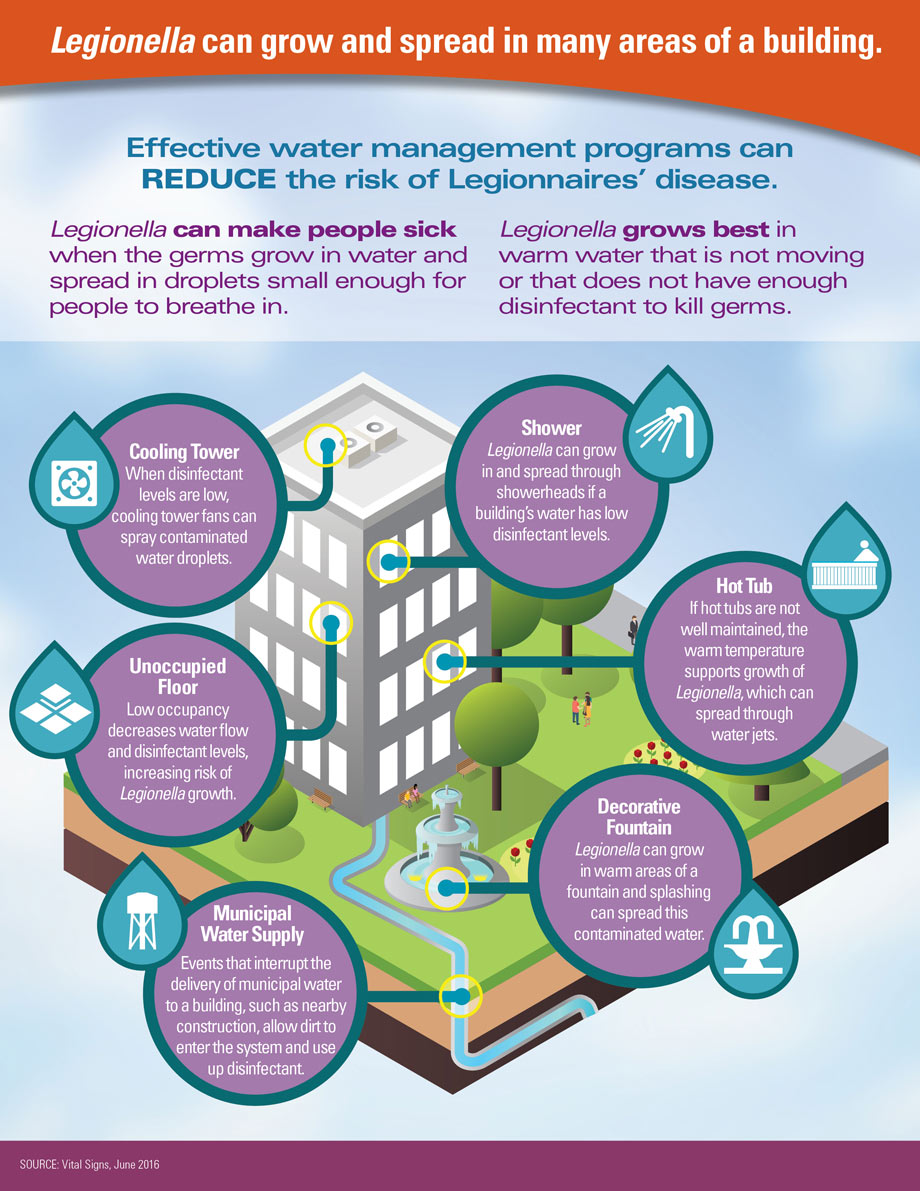Legionnaires’ Disease
Use water management programs in buildings to help prevent outbreaks
CDC investigated the first outbreak of Legionnaires’ disease, a serious lung infection (pneumonia), in 1976. An increasing number of people in the US are getting this disease,1,2, which is caused by breathing in small water droplets contaminated with Legionella germs. About 5,000 people are diagnosed with Legionnaires’ disease and there are at least 20 outbreaks reported each year.1,2 Most identified outbreaks are in buildings with large water systems, such as hotels, long-term care facilities, and hospitals.*4 Legionella grows best in building water systems that are not well maintained. Building owners and managers should adopt newly published standards5 that promote Legionella water management programs, which are ways plans to reduce the risk of this germ in building water systems.
Building owners and managers can:
- Learn about and follow newly published standards for Legionella water management programs. http://bit.ly/1Ph3wQP
- Determine if the water systems in their buildings are at increased risk of growing and spreading
- Develop and use a Legionella water management program as needed. cdc.gov/legionella/WMPtoolkit
- Monitor and respond to changes in water quality.

The number of people with Legionnaires’ disease grew by nearly 4 times from 2000–2014.
Legionnaires’ disease is deadly for about 10% of people who get it.
9 in 10. CDC investigations show almost all outbreaks were caused by problems preventable with more effective water management.
Water management problems can lead to Legionnaires’ disease outbreaks.
What causes Legionnaires’ disease outbreaks that CDC investigates?4
- About 1 in 2 (48%) are due to more than one of these problems.
- About 2 in 3 (65%) are due to process failures, like not having a Legionella water management program.
- About 1 in 2 (52%) are due to human error, such as a hot tub filter not being cleaned or replaced as recommended by the manufacturer.
- About 1 in 3 (35%) are due to equipment, such as a disinfection system, not working.
- About 1 in 3 (35%) are due to changes in water quality from reasons external to the building itself, like nearby construction.
Where do people get Legionnaires’ disease?
- CDC investigations of building-associated outbreaks show the most common places for getting the disease are hotels, long-term care facilities, and hospitals.4 Cruise ships are another place where Legionnaires’ disease outbreaks can happen.
- In these types of buildings, the most likely sources for spreading water droplets contaminated with Legionella include:4,6
- Showers and faucets.
- Cooling towers, which are parts of large centralized air conditioning systems.
- Hot tubs.
- Decorative fountains and water features.
Who’s most at risk for getting Legionnaires’ disease?7
- Adults 50 years or older.
- Current or former smokers and people with a chronic lung disease, such as emphysema.
- People with a weakened immune system caused by diseases or medicines.
The Federal government is:
- Providing tools for building owners and managers to understand how to develop water management programs to reduce the risk of Legionnaires’ disease.
- Working with health, academic, and industry partners to develop and evaluate guidelines and standards to prevent Legionnaires’ disease.
- Working towards including Legionnaires’ disease prevention practices in national building and public health codes.
- Improving health care for veterans by requiring plans for prevention of Legionnaires’ disease at Veterans Health Administration hospitals and long-term care facilities.
- Tracking Legionnaires’ disease and responding to outbreaks to find the source and help prevent future infections.
Building owners and managers can:
- Learn about and follow newly published standards for Legionella water management programs. http://bit.ly/1Ph3wQP
- Determine if the water systems in their buildings are at increased risk of growing and spreading
- Develop and use a Legionella water management program as needed. cdc.gov/legionella/WMPtoolkit
- Monitor and respond to changes in water quality.
State and local officials can:
- Incorporate Legionella water management programs into licensing and accreditation requirements for healthcare facilities.
- Consider changing building and public health codes to include Legionella water management programs.
- Provide tools and information to help local building owners and managers carry out Legionella water management programs.
- Investigate reports of Legionnaires’ disease promptly to prevent more people from getting sick.
Healthcare providers can:
- Tell patients if they are at increased risk for pneumonia, including Legionnaires’ disease and to seek care quickly if they develop symptoms of pneumonia.
- Test for Legionnaires’ disease in people with serious pneumonia, especially those requiring intensive care or who recently stayed in a healthcare facility or hotel or on a cruise ship. Use a urinary antigen test and a culture from a lower respiratory specimen (e.g., sputum).
- Report positive Legionnaires’ disease lab tests to local public health authorities quickly.
Issue Details
- CDC Digital Press Kit: Legionnaires’ Disease
- Vital Signs Issue details: Legionnaires’ Disease, Morbidity and Mortality Weekly Report (MMWR)
- Vital Signs – Legionnaires’ Disease [PODCAST – 1:15 minutes]
- Vital Signs – Legionnaires’ Disease [PSA – 0:60 seconds]
- About Legionnaires’ Disease
- CDC Healthy Water Website
- Model Aquatic Health Code (MAHC)
- Developing a Water Management Program to Reduce Legionella Growth and Spread in Buildings: A Practical Guide to Implementing Industry Standards
- Drinking Water Advisory Communication Toolbox
- Emergency Water Supply Planning Guide for Hospitals and Healthcare Facilities [PDF – 2 MB]
- Investigation Tools for Clusters and Outbreaks of Legionnaires’ Disease
- CDC Environmental Investigation Videos
- Legionnaires’ Disease Resources for Environmental Health Professionals
- MedlinePlus – Legionnaires’ disease
- ASHRAE Standard 188: Legionellosis: Risk Management for Building Water Systems (ANSI Approved)
- ASHRAE Guideline 12-2000: Minimizing the Risk of Legionellosis Associated with Building Water Systems
- Legionellosis Guideline: Best Practices for Control of Legionella
- Prevention of Healthcare-Associated Legionella Disease and Scald Injury from Water Systems



